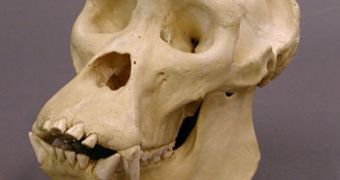A big gap in the human evolution is going to be filled. Recently found fossil teeth of a gorilla-like ape that lived about 10 million years ago are a first archaeological clue of when gorillas split off from the human-chimp lineage of apes.
The finding was made in the Afar rift valley of Ethiopia, where most important human fossil species have been discovered so far. The Ethiopian-Japanese team discovered nine teeth coming from several individuals of the large ape named Chororapithecus abyssinicus. The teeth look very much like those of present-day gorillas and this species appears to be an early ancestor (or near ancestor) of gorillas.
The team found a canine tooth in February 2006 and 8 molars in March 2007, over a distance of more than 100 km (60 mi). This is "Ethiopia's first fossil great ape," said Dr Berhane Asfaw of the Rift Valley Service in Addis Ababa. 3D microscopic techniques showed that Choropithecus fed on fibrous food items like stems and leaves, like modern-day gorillas.
"It's a subtle distinction, but we've compared it with everything we could think of and it does show some telling signs of gorilla-like molar structure. If it's not a gorilla relative, then it's something very similar to what an early gorilla must have looked like. The molars were as big as those of gorillas. Their diet probably included hard fruits and some fibrous plant materials such as stems." said Dr. Gen Suwa of the University of Tokyo.
Gorillas are the only living apes whose molar teeth are adapted to grinding tough plant items, which they can digest due to their large size, while chimps rely on softer foods, like fruit, leaves and animal stuff.
The sediment layer where the teeth were found was dated 10 to 11 million years old, an age before the human-chimp lineage, thought to have split from the other apes about 8 million years ago. But the new fossil points that the split could have taken place even earlier.
"Most molecular and DNA studies have concluded that humans and gorillas had split by at least eight million years ago, and humans and chimps by five to six million years ago. Chororapithecus indicates that a reconsideration of this assumption is needed." said the researchers.
Other fossil bones from the site, belonging to ancient monkeys and hippos, reveal Chorapithecus inhabited a wet, lush habitat.
"The big ape is the most common species here, and we don't get the three-toed horses (linked to drier savanna) which are abundant elsewhere. So it was probably a forest close to water," said Suwa.

 14 DAY TRIAL //
14 DAY TRIAL //